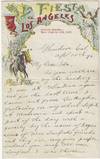Envelope or Cover
1896 · Glendora, California
by Jacob K. Miller
Glendora, California, 1896. Envelope or Cover. Very good. A four-page letter from Jacob K. Miller in Glendora, California to his wife in Cedar Rapids, Iowa. It is written on colorful La Fiesta de Los Angeles stationery and dated 15 April 1896. The letter is enclosed in a matching illustrated envelope franked with a red 2-cent Washington stamp. Both items are in nice shape.
In this letter, Miller, a dry goods salesman, informs his wife that although he had to leave Los Angeles proper to spend time in Glendora, he will be returning to Los Angeles in time for the festival, which was going to occur between 22-25 April, and then begin his trip home on the 27th. . La Fiesta de Los Angeles was a four-day long celebration originated by business leader, Max Meyberg, in 1894 to pump life back into the city’s economy and attract tourists (like that of Jacob Miller) following the depression of 1893 which shut down four banks and resulted in soaring unemployment. Its official colors were red (signifying the region’s wine groves), green for its olive trees, and orange for, well, its orange groves.
The events began with a daytime parade starting with the firing of a canon and firearms while train whistles screeched. Horse-drawn buggies, carts, and chariots traversed its downtown route, interspersed with marching bands. “Flower wars” were staged during which judges evaluated duelists who fought each other with ‘swords’ of long-stemmed flowers.
Intending to “one-up” Pasadena’s Tournament of Roses, it also included an illuminated evening parade replete with flaming torches, Chinese lanterns, and electric lights. Participants represented all of the city’s principle ethnic groups included an ‘army’ of mule-mounted prominent Anglos dressed in ridiculous costumes, Germans, Hispanics, Native Americans displaying their horsemanship as well as traditional dances atop a float, and Chinese who marched under a 200-foot-long dragon.
Events continued for the rest of the week and included fireworks, flower displays, theatrical performances, and a masked ball.
The annual event became a rousing success until it was terminated at the onset of World War I. A short-lived attempt to revive the festival was made during the depression and intermittently in the 1970s and 1980s until it seemingly shut down permanently following a murder and multiple stabbing in 1986. However, it was revived once more as Fiesta Broadway which has become a huge celebration tied to Cinco de Mayo festivities. . (Inventory #: 010445)
In this letter, Miller, a dry goods salesman, informs his wife that although he had to leave Los Angeles proper to spend time in Glendora, he will be returning to Los Angeles in time for the festival, which was going to occur between 22-25 April, and then begin his trip home on the 27th. . La Fiesta de Los Angeles was a four-day long celebration originated by business leader, Max Meyberg, in 1894 to pump life back into the city’s economy and attract tourists (like that of Jacob Miller) following the depression of 1893 which shut down four banks and resulted in soaring unemployment. Its official colors were red (signifying the region’s wine groves), green for its olive trees, and orange for, well, its orange groves.
The events began with a daytime parade starting with the firing of a canon and firearms while train whistles screeched. Horse-drawn buggies, carts, and chariots traversed its downtown route, interspersed with marching bands. “Flower wars” were staged during which judges evaluated duelists who fought each other with ‘swords’ of long-stemmed flowers.
Intending to “one-up” Pasadena’s Tournament of Roses, it also included an illuminated evening parade replete with flaming torches, Chinese lanterns, and electric lights. Participants represented all of the city’s principle ethnic groups included an ‘army’ of mule-mounted prominent Anglos dressed in ridiculous costumes, Germans, Hispanics, Native Americans displaying their horsemanship as well as traditional dances atop a float, and Chinese who marched under a 200-foot-long dragon.
Events continued for the rest of the week and included fireworks, flower displays, theatrical performances, and a masked ball.
The annual event became a rousing success until it was terminated at the onset of World War I. A short-lived attempt to revive the festival was made during the depression and intermittently in the 1970s and 1980s until it seemingly shut down permanently following a murder and multiple stabbing in 1986. However, it was revived once more as Fiesta Broadway which has become a huge celebration tied to Cinco de Mayo festivities. . (Inventory #: 010445)





